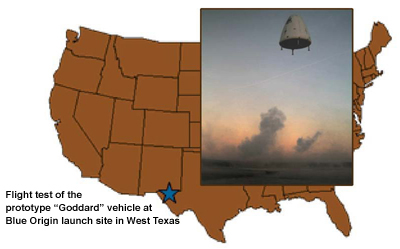Secretive Space Vehicle Tested at Private Texas Site

That secretive rocket work beingbankrolled by billionaire Jeff Bezos of Amazon.com fame has shed some new lighton its activities.
Blue Origin is developing NewShepard, a rocket-propelledvehicle that takesoff and lands vertically and is designed to routinely fly multipleastronauts into suborbital space at competitive prices. ?
Flight tests of the suborbital crafthave been staged at a privatelaunch site in Texas.
Blue Origin is now noting that, inaddition to providing the public with opportunities to experience spaceflight,New Shepard will also provide frequent opportunities for researchers to flyexperiments into space and a microgravity environment.
To help shape this activity, thegroup has announced that interested parties should contact Blue Origin'sindependent representative for research and education missions, Alan Stern, theformerNASA chief of space science.
These research and educationmissions are dubbed REM, oriented toward microgravity and space scienceinvestigations.
This activity would be in additionto, not in place of, Blue Origin's long-standing plans for human-carryingcommercial flights. The first opportunities for autonomous or remotelycontrolled experiments on unpiloted flights could be as early as 2011 and thefirst ones requiring accompanying research astronauts would be available asearly as 2012.
Breaking space news, the latest updates on rocket launches, skywatching events and more!
Coasting into space
In a mission overview, Blue Origin explains that the NewShepard vehicle will consist of a pressurized Crew Capsule (CC) carryingexperiments and astronauts atop a Propulsion Module (PM).
Flights will take place from BlueOrigin's own launch site, which is already operating in West Texas. New Shepardwill take-off vertically and accelerate for approximately two and a halfminutes before shutting off its rocket engines and coasting into space.
The vehicle will carry rocket motorsenabling the Crew Capsule to escape from the PM in the event of a seriousanomaly during launch. In space, the Crew Capsule will separate from the PM andthe two will reenter and land separately for re-use.
The Crew Capsule will land softlyunder a parachute at the launch site. Astronauts and experiments will experienceno more than a 6g acceleration and a 1.5g lateral acceleration during a typicalflight. High-quality microgravity environments will be achieved for durationsof three or more minutes, depending on the mission trajectory.
Call for investigators
Blue Origin is soliciting input frominvestigators to help design research astronaut and experiment accommodations.Researchers will have the opportunity to provide their own racks to mount intothe vehicle (subject to a safety review), or use standard racks and services tomount their experiments.
Flight experiments may beautonomous, remotely operated, or operated manually by an accompanyingresearcher provided by the customer or by Blue Origin.
As for a timeline, Blue Origin notesthat flight testing of prototype New Shepard vehicles began in 2006. The group expectsthe first opportunities for experiments requiring an accompanying researcherastronaut to be available in 2012. Flight opportunities in 2011 may beavailable for autonomous or remotely-controlled experiments on an unpiloted flighttest.
Experiment listing
Preliminary accommodations andstandard services Blue Origin anticipates will be available include:
- Capacity — threeor more positions to be used by astronauts or experiment racks
- Experiment MassAllocation — 120 kilograms available per position (including rack)
- Windows — Oneper position
- Data recording —Experiment data storage provided for post-flight download with synchronizedtrajectory parameter measurements
As for the kinds of experiments thatcould be flown, Blue Origin's website lists remote sensing, such as atmosphericscience and Earth observations, sampling of the atmosphere and magnetosphericmeasurements. In-cabin science investigations are listed too, includingphysiology, gravitational biology or microgravity physics research.
Still under study is possiblelaunching of deployable payloads from the New Shepard.
NASA interest
Blue Origin's interest in suborbitalscience, like other rocket firms, is being stoked by NASA creating a programoffice to explore this arena at the space agency's Ames Research Center.
That office is investigating the useof emerging commercial suborbital vehicles for scientific research, including,but not limited to, flights to space of researchers to allow for human-tendedexperiments.
By the way, a Human-TendedSuborbital Science Workshop is on tap next week at the Westin San Francisco Market Street. That Dec. 15 workshop is being held in conjunction with theAmerican Geophysical Union Fall Meeting and is sponsored by the UniversitiesSpace Research Association.
- Video - Blue Origin's Goddard Vehicle Test Launch
- More About Blue Origin's Plans
- Special Report: Space Tourism
LeonardDavid has been reporting on the space industry for more than four decades. Heis past editor-in-chief of the National Space Society's Ad Astra and SpaceWorld magazines and has written for SPACE.com since 1999.

Leonard David is an award-winning space journalist who has been reporting on space activities for more than 50 years. Currently writing as Space.com's Space Insider Columnist among his other projects, Leonard has authored numerous books on space exploration, Mars missions and more, with his latest being "Moon Rush: The New Space Race" published in 2019 by National Geographic. He also wrote "Mars: Our Future on the Red Planet" released in 2016 by National Geographic. Leonard has served as a correspondent for SpaceNews, Scientific American and Aerospace America for the AIAA. He has received many awards, including the first Ordway Award for Sustained Excellence in Spaceflight History in 2015 at the AAS Wernher von Braun Memorial Symposium. You can find out Leonard's latest project at his website and on Twitter.
